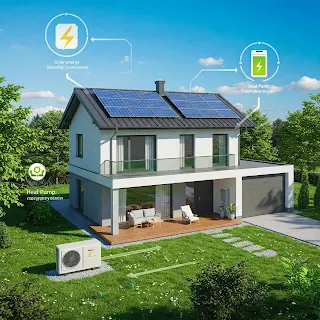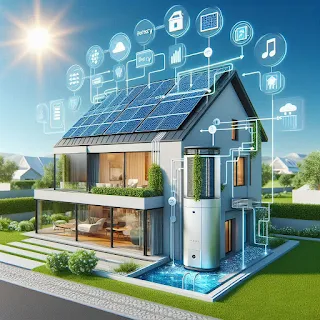The global energy transition is gaining momentum, with a growing focus on renewable energy systems that offer reliability, efficiency, and sustainability. One of the most promising solutions is the integration of solar power systems with advanced storage technologies and heat pumps. This combination not only optimizes energy use but also significantly reduces dependence on conventional energy sources. In this article, we delve into how solar-plus-storage systems combined with heat pumps can transform energy management in residential and commercial applications.
The Rise of Solar Energy and Its Challenges
1.1 Solar Power Adoption Worldwide
Solar photovoltaic (PV) technology has seen exponential growth in the last decade due to declining costs, government incentives, and increased public awareness about climate change. According to the International Energy Agency (IEA), solar PV is expected to account for more than 30% of global electricity generation by 2050.
1.2 Key Limitations of Standalone Solar Systems
Despite the progress, standalone solar systems face limitations:
Intermittency due to weather conditions and daylight availability
Limited energy storage capabilities
Energy wastage when generation exceeds demand
2. The Role of Energy Storage in Solar Systems
2.1 What is Solar-Plus-Storage?
Solar-plus-storage refers to the integration of solar PV panels with battery storage systems. This configuration allows excess solar energy generated during the day to be stored and used during the night or cloudy periods.
2.2 Benefits of Adding Storage
Enhanced energy reliability
Reduced reliance on grid electricity
Increased self-consumption
Improved system efficiency and economic viability
2.3 Types of Energy Storage Systems
Lithium-ion Batteries: Widely used for their high energy density and efficiency
Thermal Batteries (PHPS): Store energy in the form of heat, offering an alternative to chemical batteries
Flow Batteries: Suitable for large-scale, long-duration energy storage
3. Heat Pumps: A Complementary Technology
3.1 What are Heat Pumps?
Heat pumps are devices that transfer heat from one place to another, often from the air or ground to indoor spaces. They can be used for both heating and cooling, making them highly versatile.
3.2 Types of Heat Pumps
Air Source Heat Pumps (ASHP)
Ground Source Heat Pumps (GSHP)
Water Source Heat Pumps (WSHP)
3.3 Efficiency and Environmental Benefits
Heat pumps are significantly more efficient than traditional heating systems. For every unit of electricity consumed, a heat pump can deliver 3-4 units of heating or cooling energy.
4. Integrating Solar-Plus-Storage with Heat Pumps
4.1 System Architecture A typical integrated system consists of:
Solar PV panels generating electricity
Battery storage (lithium-ion or thermal)
Heat pump for space or water heating
Smart controllers for energy flow optimization
4.2 Benefits of Integration
Increased Energy Self-Sufficiency: Stored solar energy can power heat pumps, reducing the need for grid power.
Load Shifting: Heat pumps can be scheduled to run during peak solar generation, enhancing self-consumption.
Cost Efficiency: Reduced energy bills and improved return on investment.
Environmental Impact: Lower carbon footprint through reduced fossil fuel use.
5. Case Study: Research from the Technical University of Madrid
5.1 System Design and Simulation
Researchers at the Technical University of Madrid developed a hybrid system combining lithium-ion batteries, thermal batteries (PHPS), solar PV, and heat pumps. The study simulated energy flows and performance in residential applications.
5.2 Key Findings
PV self-consumption increased by up to 20%
Levelized Cost of Energy (LCOE) reduced by 7%
Enhanced reliability during power outages
5.3 Implications for Wider Adoption
This research highlights the technical and economic viability of integrated systems. It sets a precedent for future residential and commercial energy systems that are resilient, affordable, and sustainable.
6. Implementation Considerations
6.1 Economic Feasibility
Initial setup costs remain high but are offset by long-term savings
Government incentives and financing options can improve affordability
6.2 Technical Requirements
Smart inverters and controllers
Efficient thermal storage design
System compatibility and scalability
6.3 Regulatory and Policy Support
Policies supporting feed-in tariffs, net metering, and tax credits are crucial
Building codes should encourage energy-efficient and renewable systems
7. Future Prospects and Innovations
7.1 AI and Smart Grid Integration
AI can predict energy generation and consumption patterns, optimizing the performance of integrated systems. Smart grids will allow dynamic energy exchange and grid responsiveness.
7.2 Thermal Battery Advancements
Ongoing R&D aims to improve thermal battery efficiency, storage density, and cost-effectiveness.
7.3 Community-Scale Applications
Shared energy systems using solar-plus-storage and heat pumps can serve entire neighborhoods, increasing energy equity.
Conclusion
The integration of solar-plus-storage systems with heat pumps represents a groundbreaking advancement in sustainable energy technology. By addressing the limitations of standalone systems and maximizing energy efficiency, this approach offers a comprehensive solution to the energy challenges of today and tomorrow. With continued innovation and policy support, these integrated systems could become the cornerstone of future energy infrastructure, enabling a cleaner, more resilient, and cost-effective energy future.


No comments:
Post a Comment